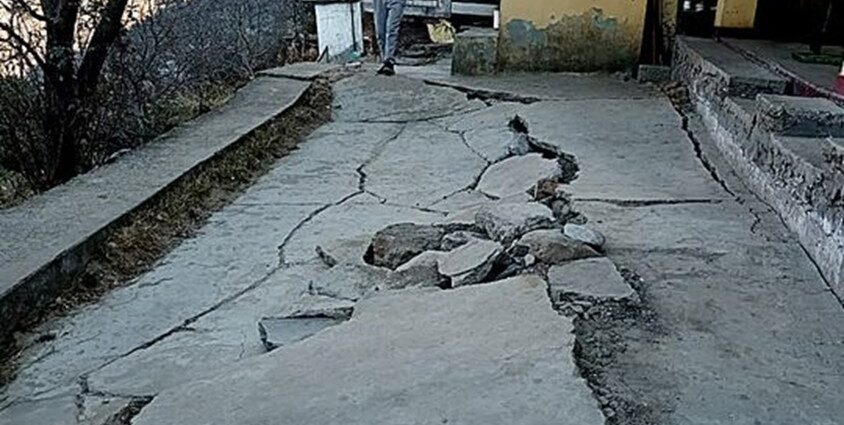Flash floods from Chorabari lake in Uttarakhand on June 17, 2013 carrying rocks and silt was a monumental tragedy that struck the holy shrine of Kedarnath on its way. It killed some 6500 people, destroyed property and infrastructure worth hundreds of crores constructed so labouriously spanning decades. The State was not caught unaware as Indian Meteorological Department had predicted heavy rains and floods. Due regard and publicity of the climate warning were not given by the government authorities and crores of tourists, and pilgrims visiting Badrinath, Kedarnath, Gangotri, Yamunotri and Hemkund Sahib were caught unaware, getting trapped in the avoidable disaster ruthlessly.
The calamity was certainly man-made as usual caused by reckless constructions, overflowing tourism, the burgeoning number of diesel-driven vehicles poisoning hills, intensive mining in the fragile eco-system, and unheeded public warnings with no plans of large-scale evacuation in emergency situations that exacerbated the tragedy. Congress regime of the State was squarely responsible for the monumental disaster and mismanagement of relief works while Congress minions had a field day in exploiting the tragedy to fill their coffers. Offer of the then Gujarat Chief Minister Narendra Modi to undertake rescue missions were turned down due to petty political rivalries notwithstanding the human tragedy at stake. It was a glaring example of how political slug-fest too is a severe climate hazard!
Have we learned any lessons from the catastrophe? Doesn’t appear to be so. There is so much commercialisation of natural assets that the unmitigated human greed of lucre drives crores of innocents into calamities of grave dimensions. Three Shankaracharya-s had appealed a few months ago not to convert pilgrimage shrines into tourist hubs. It appears to have fallen on deaf ears as the ‘molestation’ of hills continues unabated. Recently a Jain pilgrimage shrine in Jharkhand too was proposed to be destroyed as a tourist hub which the central and state governments were forced to withdraw in view of the massive protest by Jains. Why do authorities indulge in such disastrous activities knowing very well about large-scale damage that may be inflicted?
And now the Joshimath calamity. The entire town is gradually sinking leading to massive cracks and fissures in houses, walls, huge cavities on roads etc. According to the Director of the Wadia Institute Of Himalayan Geology, a variety of anthropogenic and other natural factors are responsible for the subsidence of the town. As usual, a stream of warnings went unheeded as the sinking phenomenon has been growing over a long period of time. According to them, three principal factors having caused the sinking happens to be the foundation of the district on debris of a century-old landslide triggered by an earthquake, being in seismic zone-V and gradual water percolation reducing the strength of rocks underneath. These ecological factors of landslide were highlighted in the Himalayan Gazetteer in 1886 and by Mishra Committee in 1976. So the alarm bells were tolled as early as 1976! The area is highly glaciated with soil weak and flowing water eroding the very foundation of the town. Here too, unplanned and unrestricted construction activity, frequent heavy rains, etc. have intensified the crisis. A large number of houses have been severely damaged to being highly risk-prone now and residents are forced to spend nights outside their homes in night chill. During a recent visit of the Uttarakhand Chief Minister to the town, residents broke into tears while narrating their agonies. They are clueless as to how to go about surviving after spending their life savings on building the houses which have to be abandoned now. NTPC has been accused of damaging the ecosystem by tunneling the area for a hydel project which they have vehemently denied and asserted, the exercise was undertaken after due diligence. Notably, it is very evident that any kind of tunneling in an eco-sensitive area is bound to be a monumental disaster.


As a matter of concern, Joshimath is not the lone sinking phenomenon in the Uttarakhand hills. Several such disasters have been recorded in past like Garbyang in district Dharchula, Bagi in Uttarkashi, etc. Garbyang, once a trade centre, has been sinking for decades as reported in the Economic Times dated Jan. 10, 2023. Munshiyari block of Pithoragarh district and Bagi reported cracks as early as the 1990s. Extensive water harvesting too is a factor for seepage as discovered in the case of Umli-Bandarigaon. Experts have already demanded a complete ban on deforestation, mining and road construction activities in all vulnerable belts
Wadia Institute has suggested micro-zonation of the town, re-laying of the entire drainage system, creating rainwater outlets, and evaluation of rock strength to be undertaken after the evacuation of all residents. Is such an exercise of complete renovation of the town involving huge capital expenditure worth it? Alternately residents may be rehabilitated in other towns under various housing schemes of State and Central Governments while the town may be abandoned altogether to be returned to nature with the passage of time.
Now that the Prime Minister’s Office has entered the scenario and directed the State Government to address the crisis on a war footing by ordering an inter-disciplinary investigation of the affected area, a time-bound reconstruction plan, and continuous seismic monitoring of the area, we hope hapless residents will not have to suffer for a long period of time. PMO must also order remedial measures for all such towns and districts vulnerable to land subsidence in the state of Uttarakhand.
Image sourced from internet.
Kindly donate to Bharat Voice at https://rzp.io/l/5HCr6XZNU .
![]()
- ‘MY EXPERIMENTS WITH DECEIT AND DUPLICITY’ BY ‘MAHATMA’ MK GANDHI - January 30, 2023
- MYSTICISM OF ASTANGAYOGA OF MAHARSI PATANJALI - January 21, 2023
- ANY LESSON LEARNT FROM KEDARNATH TO JOSHIMATH AND BEYOND? - January 11, 2023

